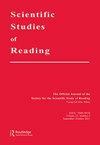四年级阅读风险的早期预测:潜在类分析与分类树相结合的方法
IF 2.4
2区 教育学
Q1 EDUCATION & EDUCATIONAL RESEARCH
引用次数: 0
摘要
四年级的教学通常从“学到读”转变为“读到学”,这可能会让学生感到困惑。然而,以评估为指导的早期阅读干预在预防后期阅读困难(RD)方面已被证明是有效的。本研究提出一个分类回归树(CART)模型,利用一年级的测量方法来预测四年级的阅读小组。方法对一、四年级学生进行评估(N = 452)。使用基于单词阅读和阅读理解测量的潜类分析来确定四年级组,切割点为第15百分位。训练CART模型以确定最佳决策规则,对有发展后期RD风险的学生进行分类,并与逻辑回归模型进行比较。结果重要的一年级预测指标包括口语和基本的单词阅读技能,最终分类准确度估计为0.90 AUC, 0.91敏感性和0.75特异性。结论CART与logistic回归模型的分类准确率相近,CART的优势在于为从业者提供了更直观的风险判断方法。多变量筛查可能很耗时,但CART模型提供了减少误报和指导有针对性干预的潜力,从而更好地利用学校资源。本文章由计算机程序翻译,如有差异,请以英文原文为准。
Early Prediction of Reading Risk in Fourth Grade: A Combined Latent Class Analysis and Classification Tree Approach
ABSTRACT Purpose Fourth grade typically involves shifting the instruction from learning to read to reading to learn, which can cause students to struggle. However, early reading intervention guided by assessment has demonstrated effectiveness in preventing later reading difficulties (RD). This study presents a classification and regression tree (CART) model predicting fourth-grade reading groups using first-grade measures. Method Students were assessed in first and fourth grade (N = 452). Fourth-grade groups were determined using latent class analysis based on word reading and reading comprehension measures with a cut-point at the 15th percentile. A CART model was trained to determine the best decision rules to classify students at risk of developing later RD and compared to a logistic regression model. Results Important first-grade predictors included a mix of oral language and foundational word-reading skills with final classification accuracy estimates of .90 AUC, .91 sensitivity, and .75 specificity. Conclusion While the CART and logistic regression models’ classification accuracy was similar, CART has the advantage of offering a more intuitive way for practitioners to determine risk. Multivariate screening can be time-consuming, but CART models offer the potential to reduce false positives and guide targeted interventions, leading to better use of school resources.
求助全文
通过发布文献求助,成功后即可免费获取论文全文。
去求助
来源期刊

Scientific Studies of Reading
Multiple-
CiteScore
7.20
自引率
2.70%
发文量
26
期刊介绍:
This journal publishes original empirical investigations dealing with all aspects of reading and its related areas, and, occasionally, scholarly reviews of the literature, papers focused on theory development, and discussions of social policy issues. Papers range from very basic studies to those whose main thrust is toward educational practice. The journal also includes work on "all aspects of reading and its related areas," a phrase that is sufficiently general to encompass issues related to word recognition, comprehension, writing, intervention, and assessment involving very young children and/or adults.
 求助内容:
求助内容: 应助结果提醒方式:
应助结果提醒方式:


